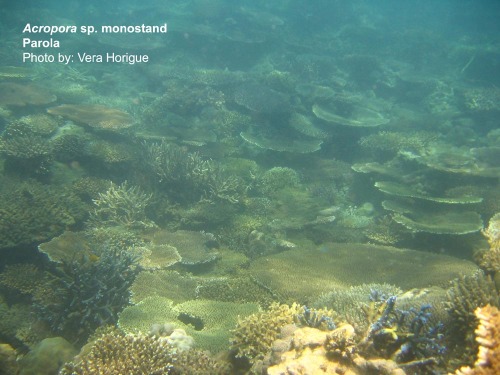Dr. Kent Carpenter, a well-known marine biologist and fish taxonomist called the coral reefs of the Verde Island Passage as the Amazon of the Sea. The Philippines he said (VIP in particular), was the centre of the centre of marine biodiversity.
The Philippines, with Malaysia, Indonesia, Papua New Guinea, Timor Leste and the Solomon Islands, form the Coral Triangle. The Coral Triangle was said to be the centre of marine biodiversity as it holds more than 30% of the world’s coral reefs. Over 600 coral species and 3,000 reef fish species are found in the Coral Triangle. Whereas, the Philippines and Indonesia has been dubbed as the top two countries with reefs with the highest biodiversity.
Coral reefs play important ecological and economical roles. It serves as buffer zone that protects coastlines from wave action and erosion. It is one of the most diverse and productive ecosystems. It plays a crucial role on fishery production as it also serves as a nursery, feeding ground and important habitat to various species of reef fishes and other invertebrates. They provide various livelihood opportunities from fisheries to tourism.
Coral reefs are also one of the most sensitive ecosystems. They are limited by depth and thrive in well lit, shallow waters of the tropical oceans. They do not thrive in areas with high sediment inputs, because they are prone to smothering. They are sensitive to temperature, thus they are bound in equatorial waters by the 20 °C isotherm. The optimal reef development occurs in waters where in the mean annual temperature ranges from 23 to 25 °C. They are intolerant to significant changes in salinity that is why they are absent in areas such as river mouths due to the high freshwater influx.
The Coral Triangle is one of the top priorities of research and conservation actions to date. This is due to the Southeast Asian nations that continue to face development and exploitation pressures, despite the awareness of coral reefs’ ecological and economic importance. To date, common threats are due to human activities that are hardly mitigated. It may not be as rampant as it used to be decades ago, but coral reefs are still threatened by illegal fishing methods, pollution, land-based activities and coral and reef fish harvesting for aquarium fishery. Adding more stress is the impending threats of climate change.

Bleaching used to be a major threat as it wiped out large areas of reefs during the mass bleaching event in 1997 to 1998. Bleaching occurs due to the increase in sea surface temperatures. Another cause of bleaching that is being considered is increased irradiance or light exposure. Increases in both temperature and irradiance during hot periods disrupt the photosynthetic symbionts of the corals – the zooxanthellae, by inhibiting photosynthesis and other stress processes.
Scientists recently have seen that other climate change effects apart from irradiance and increased sea surface temperatures that have deleterious effects on coral reefs are increasing strength and frequency of storms, and ocean acidification. Storms and typhoons cause physical damage to reefs. Where as ocean acidification, or decrease in seawater pH, inhibits coral calcification and thus damages the corals’ skeletal structure and resilience.
Damaging coral communities will result to a shift to algal dominance. Reef fishes and other invertebrates will lose their habitat and shelter. Modelling studies have shown that in worst case scenarios, local extinctions of sensitive, rare and highly specialised species will occur. Eventually this will become global in scale. Other fishes and invertebrates will have reduced population sizes which will lead to reduced reproduction and recruitment and longer recovery times. Ultimately, the ecosystems will become less ecologically complex, which will result to reduction of biodiversity. Reduction on biodiversity, will then lead to the loss of ecosystem services, which will lessen livelihood opportunities and sources.
As Filipinos, our responsibility for our natural resources should not just end in awe and being proud that our country is rich in biodiversity and natural resources. We need to get more involved as time is running out. It is not yet too late to do something. We should not depend on foreign organisations, international and local scientists and environmental advocates to do all the studying and lobbying. We as a society should think that we still want younger generations to continue to be proud that our country’s coral reefs are considered an equal to the Amazon Forest.
————————————————————
Note: If you have any queries, please include your email address in your comments so that I would be able to write to you personally. And please write in English or Filipino. I could read Spanish, Portugese, and a bit of French, but I prefer English. Thanks! – V
References:
Carpenter, K. et al. 2008. One-third of reef-building corals face elevated extinction risk from climate change and local impacts. Science. 321: 560-563.
Hoegh-Guldberg, O. 1999. Climate change, coral bleaching and the future of the
world’s coral reefs. Mar. Freshwater Res. 50: 839-866.
Hoegh-Guldberg, O., P.J. Mumby, A.J. Hooten, R.S. Steneck, P. Greenfield, E. Gomez,
C.D. Harvell, P.F. Sale, A.J. Edwards, K. Caldeira, N. Knowlton, C.N, Eakin, R.
Iglesias-Prieto, N. Muthiga, R.H. Bradbury, A. Dubi, M.E. Hatziolos. 2007. Coral reefs under rapid climate change and ocean acidification. Science. 318: 1737-1742
IPCC, 2001: Climate Change 2001: The Scientific Basis. Contribution of Working Group I to the Third Assessment Report of the Intergovernmental Panel on Climate Change. Cambridge University Press, Cambridge, United Kingdom and New York, NY, USA, 881pp.
Wilkinson, C.R. 2000. Status of coral reefs of the world. Australian Institute of Marine Science. Cape Ferguson, Queensland. 376 p.

